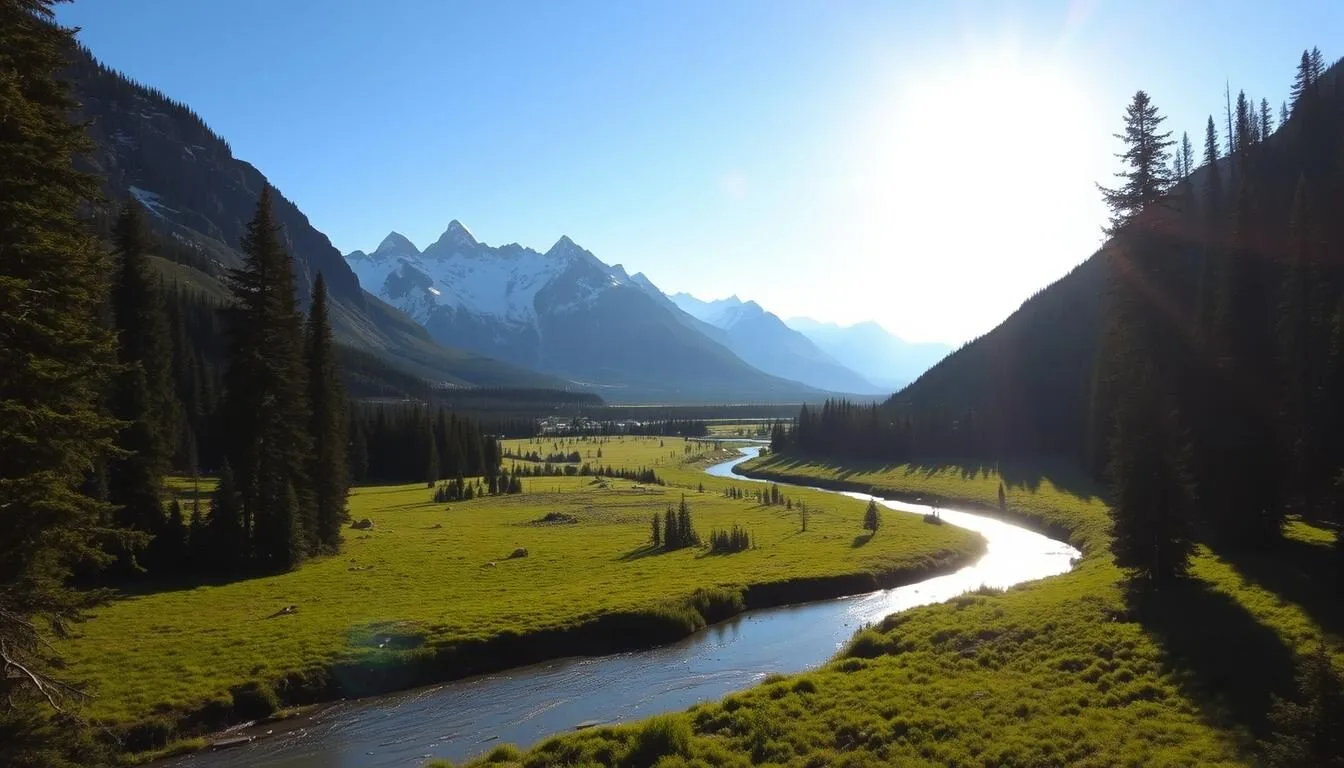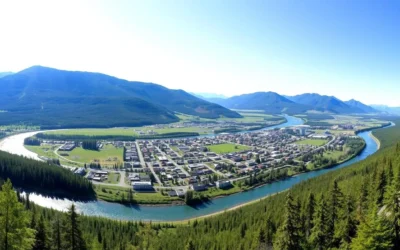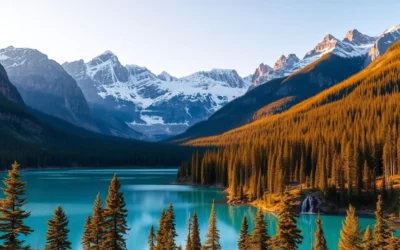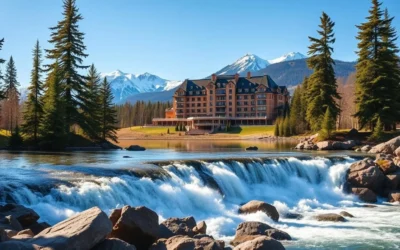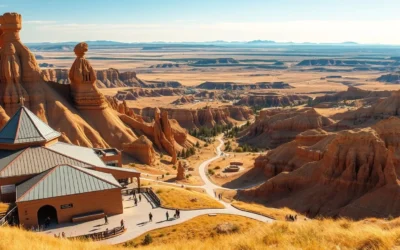✓ Accommodations✓ Flights✓ Rental Cars✓ Tours & Activities
Imagine waking up to the majestic Rocky Mountains, spending the morning hiking through glaciers, and canoeing on a turquoise lake by afternoon.
Alberta, a province in Canada, offers an unforgettable bucket list adventure with its diverse landscapes, from vast prairies to unique badlands and majestic mountains.
With two of the most visited national parks in the country, Banff and Jasper, you’ll have access to world-class outdoor activities year-round, including skiing, wildlife viewing, and exploring some of North America’s most stunning natural wonders.
Discovering Alberta’s Natural Beauty
As you explore Alberta, you’ll discover a diverse landscape that will leave you in awe. The province is home to a wide range of natural wonders, from the majestic Rocky Mountains to serene lakes and rolling prairies.
The Majestic Rocky Mountains
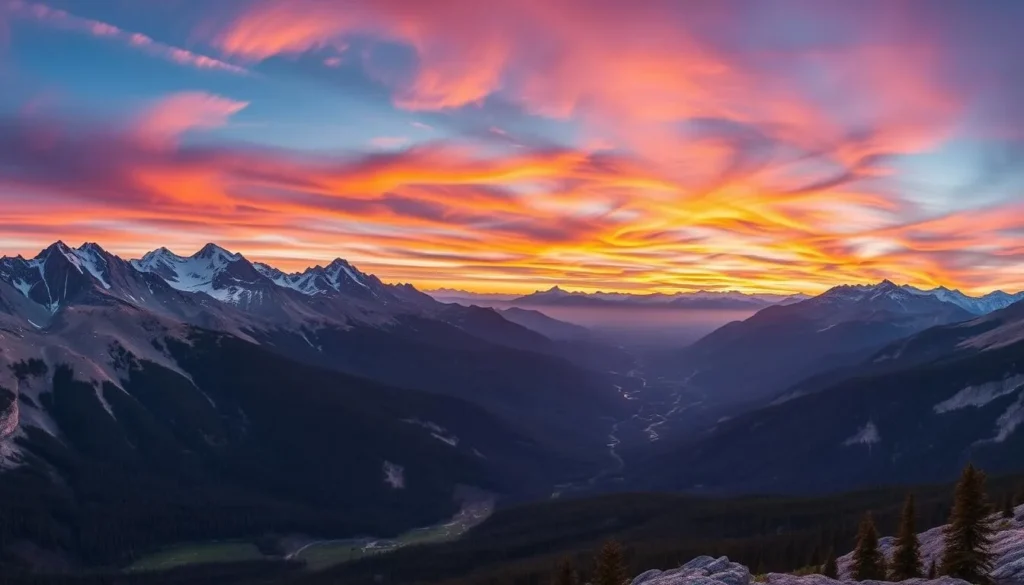
The Rocky Mountains in Alberta are a breathtaking sight, with towering peaks, alpine meadows, and glacial valleys that create a photographer’s paradise. The best time to visit the Rocky Mountains in Alberta is during the summer months when the weather is warm and wildflowers are in bloom. You can hike, camp, or simply take in the views of the majestic mountains.
The Rocky Mountains offer some of the most spectacular mountain scenery in the world. You can explore the mountains by hiking, biking, or taking a scenic drive through Banff National Park.
Alberta’s Stunning Lakes and Rivers
Alberta is home to over 600 lakes, including the famous Lake Louise and Moraine Lake. The province’s river systems, including the Bow, Athabasca, and North Saskatchewan, carve through the landscape, creating stunning valleys and providing opportunities for rafting, fishing, and wildlife viewing.
You can enjoy a variety of activities on Alberta’s lakes and rivers, such as canoeing, kayaking, or fishing. The serene beauty of the lakes and rivers is a perfect complement to the majestic Rocky Mountains.
Banff National Park: Canada’s Crown Jewel
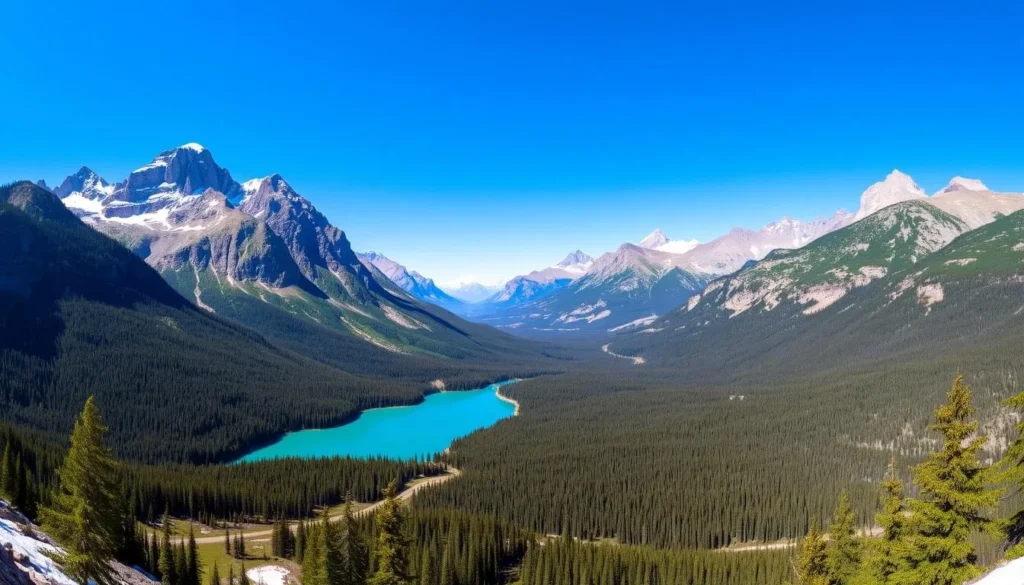
As Canada’s first national park, Banff National Park stands out as a premier tourist attraction, drawing millions of visitors each year. With its stunning mountain landscapes, picturesque lakes, and rich biodiversity, Banff National Park is a paradise for outdoor enthusiasts and nature lovers.
Exploring the Town of Banff
The charming town of Banff offers a perfect base for exploring the national park. With its picturesque main street, Banff Avenue, lined with shops, restaurants, and historic buildings, the town is surrounded by breathtaking mountain views. You can spend your days hiking, exploring the local culture, or simply enjoying the natural beauty that surrounds you.
Lake Louise: The Jewel of the Rockies
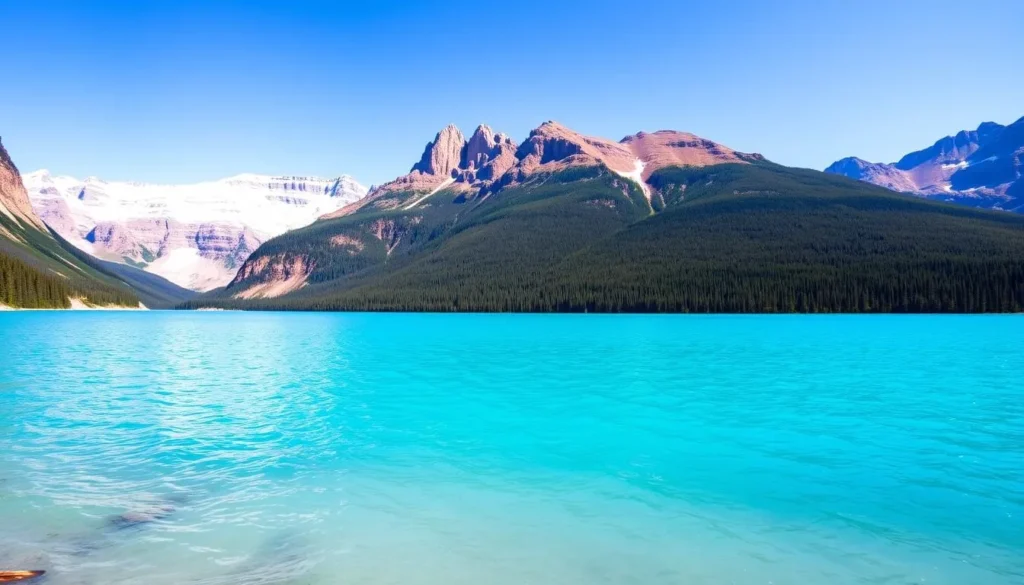
Lake Louise, located about 40 minutes from the town of Banff, is a favorite spot for many visitors. Its turquoise waters, surrounded by towering mountains and the historic Fairmont Chateau Lake Louise, make it a truly unique destination. To make the most of your visit, make sure to arrive early in the morning to avoid the crowds, especially during the summer months.
For a closer look at Lake Louise, you can rent a canoe or take a leisurely stroll around the lake. The Lake Agnes Tea House hike is one of the most popular activities, offering stunning views and a charming mountain tea house experience after a moderate 3.5 km hike.
Moraine Lake’s Turquoise Waters
Moraine Lake is arguably one of the most beautiful lakes in the world, with its brilliant blue color and the backdrop of the Ten Peaks. Due to its extreme popularity, visiting Moraine Lake now requires some planning. Private vehicles are no longer permitted, so visitors must use shuttle services or guided tours to access this natural wonder.
In addition to Lake Louise and Moraine Lake, Banff National Park is home to Lake Minnewanka, the largest lake in the park. Lake Minnewanka offers boat tours, hiking, and even scuba diving to an underwater ghost town that was flooded when a dam was built in the 1940s. You could easily spend days exploring just Banff National Park alone, with its countless hiking trails, wildlife viewing opportunities, and scenic drives throughout its 6,641 square kilometers.
Jasper National Park: Wilderness and Wonder
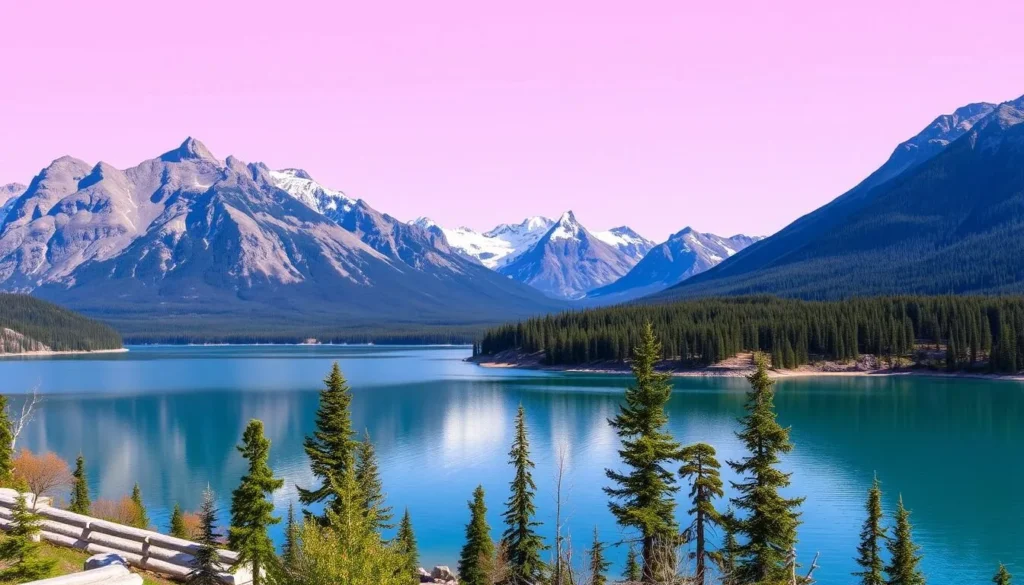
Jasper National Park is a breathtaking destination that embodies the essence of wilderness and wonder. As the largest national park in the Canadian Rockies, it offers a more rugged and less developed wilderness experience compared to Banff National Park.
Maligne Lake and Spirit Island
Maligne Lake, the second-largest glacier-fed lake in the world, is a must-visit attraction in Jasper National Park. Take a 90-minute boat cruise to Spirit Island, a picturesque islet surrounded by turquoise waters, and enjoy spectacular views of the surrounding mountains.
Jasper SkyTram: Panoramic Mountain Views
The Jasper SkyTram, the longest and highest guided aerial tramway in Canada, takes you to an elevation of 2,263 meters, offering panoramic views of six mountain ranges and the town of Jasper nestled in the valley below. For even more breathtaking views, hike the 1.4 km summit trail to reach the true peak of Whistlers Mountain.
Dark Sky Preserve: Stargazing in Jasper
Jasper National Park is renowned for its Dark Sky Preserve, one of the 17 designated Dark Sky Preserves in Canada and the darkest of them all. The park’s minimal light pollution makes it an ideal location for stargazing, with thousands of stars, the Milky Way, and even the Northern Lights visible on clear nights. Attend the annual Jasper Dark Sky Festival in October to enhance your stargazing experience with special guest speakers, astronomy activities, and guided stargazing sessions.
The Icefields Parkway: World’s Most Scenic Drive
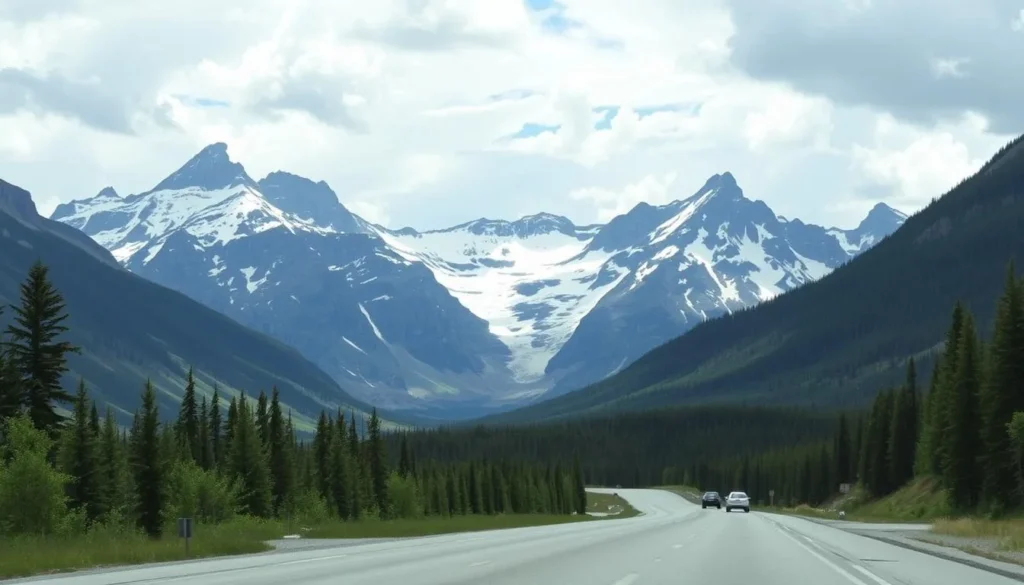
Embark on a journey through one of the world’s most breathtaking routes, the Icefields Parkway, where the Canadian Rockies unveil their majestic beauty. This 230-kilometer highway stretches between Lake Louise in Banff National Park and the town of Jasper in Jasper National Park, offering a scenic drive that is considered one of the most spectacular in the world.
The Icefields Parkway is more than just a road; it’s an immersive experience into the heart of the Rocky Mountains. As you drive along this highway, you’ll be treated to non-stop mountain vistas, turquoise lakes, ancient glaciers, and abundant wildlife viewing opportunities.
Columbia Icefield and Athabasca Glacier
The Athabasca Glacier is one of the most visited glaciers in North America, where you can ride a specially designed Ice Explorer vehicle directly onto the ancient ice for a unique walking experience on the glacier’s surface. The Columbia Icefield, feeding eight major glaciers, is a continental divide with meltwater flowing to three different oceans: the Arctic, the Atlantic (via Hudson Bay), and the Pacific.
Peyto Lake’s Breathtaking Viewpoint
Peyto Lake is renowned for its wolf-shaped lake displaying an otherworldly turquoise color due to the high concentration of glacial rock flour in the water. The viewpoint, about a 10-minute hike from the car park, offers one of the most photographed vistas in Canada.
Stunning Waterfalls Along the Route
Along the Icefields Parkway, you’ll encounter numerous stunning waterfalls, including Athabasca Falls, Sunwapta Falls, and Tangle Creek Falls, each offering short walking trails to viewing platforms. Additionally, the Big Bend and Mistaya Canyon provide unique photo opportunities and insights into the region’s geological wonders.
The Icefields Parkway is a journey that encapsulates the essence of the Canadian Rockies, with its majestic mountains, serene lakes, and dynamic glaciers. Whether you’re driving through Banff National Park or Jasper National Park, this road trip promises an unforgettable adventure.
Winter Adventures in Alberta
As snowflakes start to fall, Alberta becomes a paradise for winter sports enthusiasts. The province is home to some of the best ski resorts in North America, offering a range of exciting experiences for visitors.
World-Class Skiing and Snowboarding
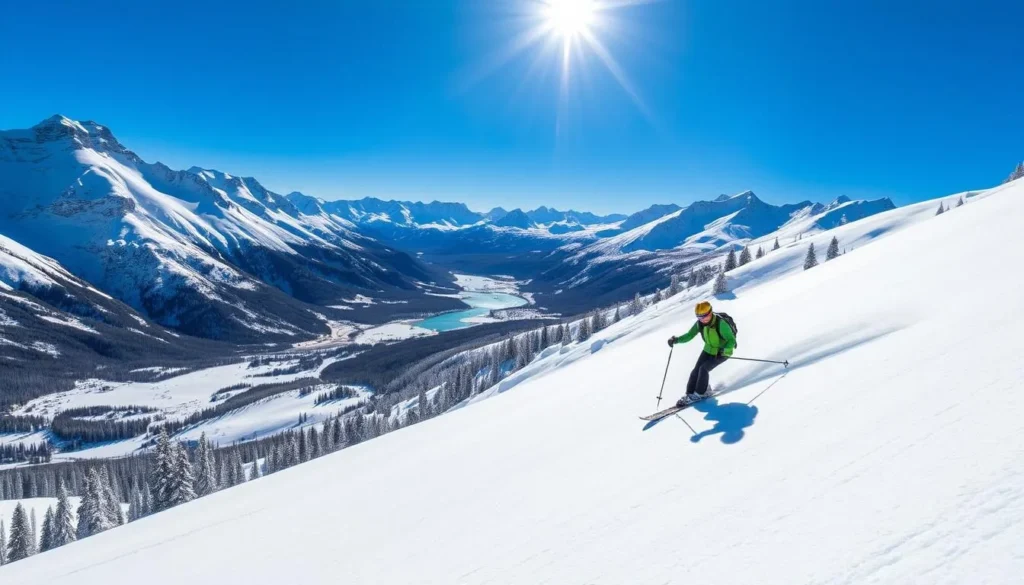
Alberta’s ski resorts are renowned for their excellent skiing and snowboarding conditions. Lake Louise Ski Resort, for instance, boasts seven ski lifts, 142 kilometers of ski runs, and a 935-meter vertical descent, making it perfect for skiers of all levels. Sunshine Village, located in Banff National Park, is ideal for advanced skiers and snowboarders, with plenty of black and double black runs. Other notable ski resorts include Mt. Norquay, known for its night skiing, and Marmot Basin in Jasper National Park, which offers 91 runs suitable for every ability.
Ice Skating on Frozen Lakes
Ice skating on any frozen lake or pond is a must-do signature experience in Alberta during the winter. Lake Louise hosts a cleared skating rink complete with an ice castle during winter months, making it a magical destination for families and couples alike. The frozen lakes offer a serene and picturesque setting, perfect for creating unforgettable memories.
Abraham Lake’s Magical Ice Bubbles
Abraham Lake is famous for its frozen methane bubbles trapped in the clear ice, creating a natural art display that draws photographers from around the world. The methane bubbles form when organic matter at the bottom of the lake decomposes and releases gas, which gets trapped as the lake freezes from November to March. This unique phenomenon makes Abraham Lake a fascinating destination for nature lovers and photographers.
Beyond skiing, snowboarding, and ice skating, Alberta offers a range of other winter activities, including ice climbing frozen waterfalls, snowshoeing through pristine forests, dog sledding adventures, and spotting wildlife against snowy backdrops. The winter season in Alberta typically runs from November through April, with January and February offering the coldest temperatures but also the most reliable snow conditions for winter activities.
Summer Outdoor Activities
As summer arrives in Alberta, the great outdoors beckons with a myriad of activities to enjoy. The province’s diverse landscapes, from towering mountains to serene lakes, offer a playground for outdoor enthusiasts.
Hiking Trails for All Skill Levels
Alberta is renowned for its hiking trails, catering to all skill levels. From leisurely strolls around lakes to challenging multi-day backpacking trips, there’s something for everyone.
Popular hiking areas include Banff and Jasper National Parks, Kananaskis Country, and Waterton Lakes National Park. Each location offers unique terrain and breathtaking scenery, making Alberta a hiker’s paradise.
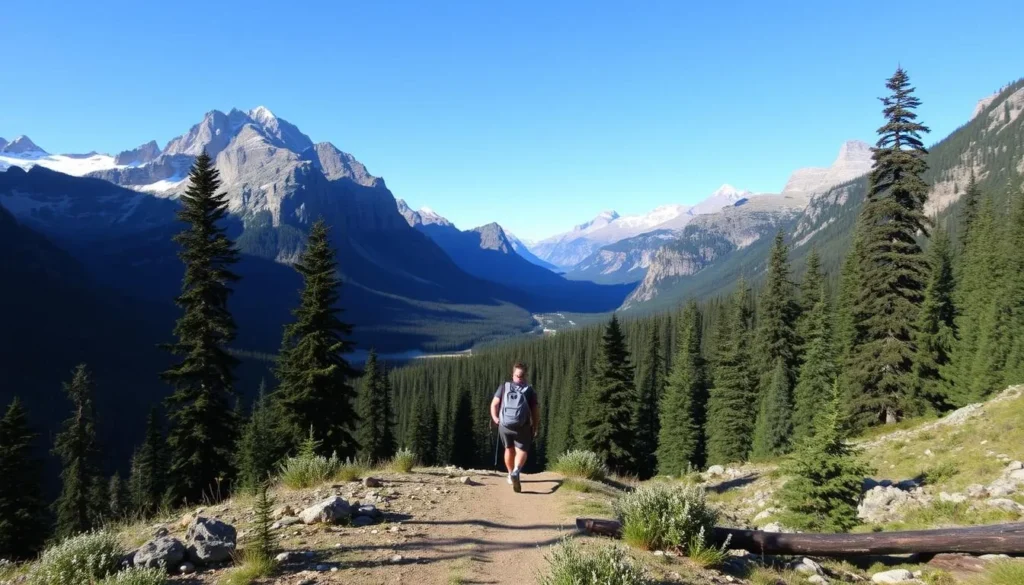
Canoeing on Alberta’s Lakes
Canoeing on Alberta’s pristine lakes is a quintessential Canadian experience. Iconic locations like Moraine Lake, Lake Louise, and Maligne Lake offer canoe rentals and unforgettable mountain backdrops.
For a more relaxed experience, floating down the Bow River through Calgary has become a popular summer activity, offering a unique perspective on the city.
Camping Under the Stars
Camping in Alberta ranges from fully-serviced campgrounds to remote backcountry sites. Options like Two Jack Lake near Banff, Boulton Creek in Kananaskis, and Wapiti in Jasper offer different experiences, ensuring that campers can find their perfect spot.
For a truly memorable experience, consider camping in one of Alberta’s dark sky preserves, where minimal light pollution allows for spectacular stargazing.
The Canadian Badlands and Dinosaur Country
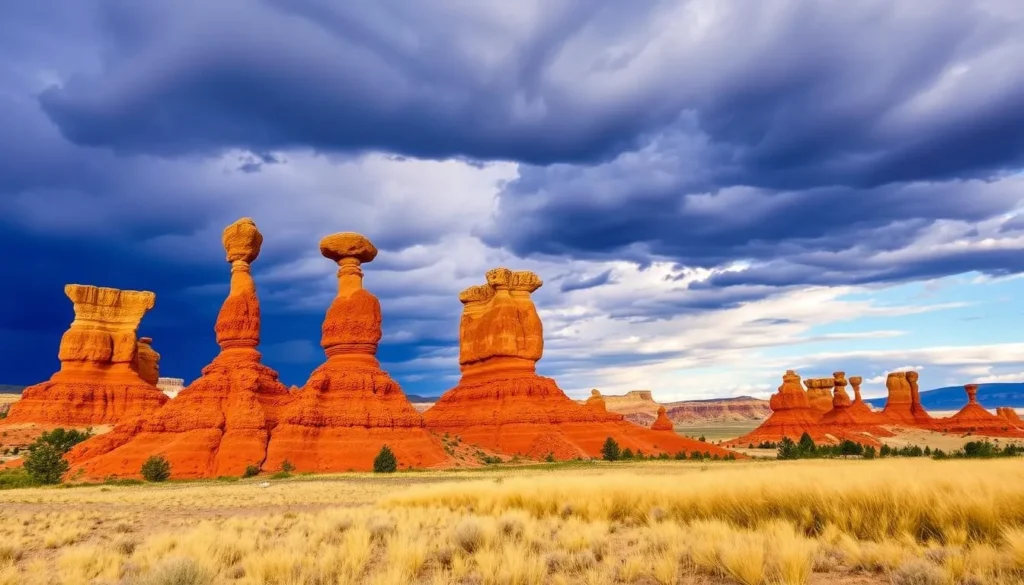
In the heart of Alberta lies the Canadian Badlands, a region renowned for its rich dinosaur fossil heritage. This area is a treasure trove for paleontologists and tourists alike, offering a glimpse into the past with its vast collection of fossils and stunning landscapes.
Royal Tyrrell Museum: World-Class Dinosaur Exhibits
The Royal Tyrrell Museum in Drumheller is a world-class destination for anyone interested in dinosaurs. With over 160,000 fossils on display, it houses the world’s largest public display of complete dinosaur skeletons. Visitors can watch technicians prepare real fossils in the preparation lab and even participate in simulated dinosaur digs.
The museum’s interactive exhibits make it an engaging experience for visitors of all ages. By exploring the museum, you can gain a deeper understanding of the history of dinosaurs and their significance in the natural world.
Hoodoos and Unique Landscapes
Beyond the Royal Tyrrell Museum, the Canadian Badlands offer breathtaking landscapes that are unlike anywhere else on Earth. The unique hoodoo formations, tall and mushroom-shaped, are a result of millions of years of erosion. You can explore these formations up close through various trails and guided tours.
Dinosaur Provincial Park, a UNESCO World Heritage Site, is another must-visit destination in the Canadian Badlands. It offers a more immersive experience than Drumheller, with stunning badlands landscapes and the highest concentration of Late Cretaceous dinosaur fossils in the world.
The park’s guided excavation tours provide a unique opportunity to see actual fossil beds where paleontologists continue to make new discoveries each year. This experience allows you to appreciate the rich paleontological heritage of Alberta and understand why it is known as the “Dinosaur Capital of the World.”
Alberta, Canada: Best Things to Do in Calgary
Calgary is a vibrant city that seamlessly blends urban charm with easy access to natural beauty. As Alberta’s largest city, it offers a perfect blend of urban attractions and proximity to the Rocky Mountains, making it one of the best base locations for exploring southern Alberta.
The Calgary Stampede
The world-famous Calgary Stampede, held annually in July, is a must-experience event. Known as “The Greatest Outdoor Show on Earth,” it combines the world’s premier rodeo competition with concerts, exhibitions, and cultural celebrations. During the 10-day Stampede, the city transforms with free pancake breakfasts, western-themed decorations, and events that attract over one million visitors annually.

Calgary Tower and Downtown Attractions
The Calgary Tower provides spectacular 360-degree views of the city and, on clear days, the distant Rocky Mountains from its observation deck 191 meters above the downtown core. Downtown Calgary is also home to the Stephen Avenue pedestrian mall, Olympic Plaza, and the architecturally stunning Central Library, named one of TIME Magazine’s World’s Greatest Places.
Heritage Park Historical Village
Heritage Park Historical Village is Canada’s largest living history museum, featuring over 180 exhibits and attractions that span Western Canadian history from the 1860s to the 1950s. The park includes a working steam train, paddlewheel boat, antique midway, and costumed interpreters who bring history to life throughout the authentically recreated historical buildings.
In addition to these attractions, Calgary offers a range of other activities. You can stroll along the Bow River and through Prince’s Island Park, explore popular neighborhoods like Kensington and Inglewood, go tubing down the river, or enjoy the views from Nose Hill Park. The National Music Centre’s Studio Bell is another highlight, showcasing Canada’s musical heritage through interactive exhibits and a collection of over 2,000 rare instruments.
Whether you’re interested in history, culture, or outdoor activities, Calgary has something for everyone. Its unique blend of urban and natural attractions makes it an ideal destination for travelers.
Edmonton: Alberta’s Capital City
Edmonton, the capital city of Alberta, is a vibrant destination that offers a mix of cultural experiences, outdoor activities, and entertainment options. As you explore this dynamic city, you’ll discover a unique blend of urban and natural attractions that make it a must-visit destination.
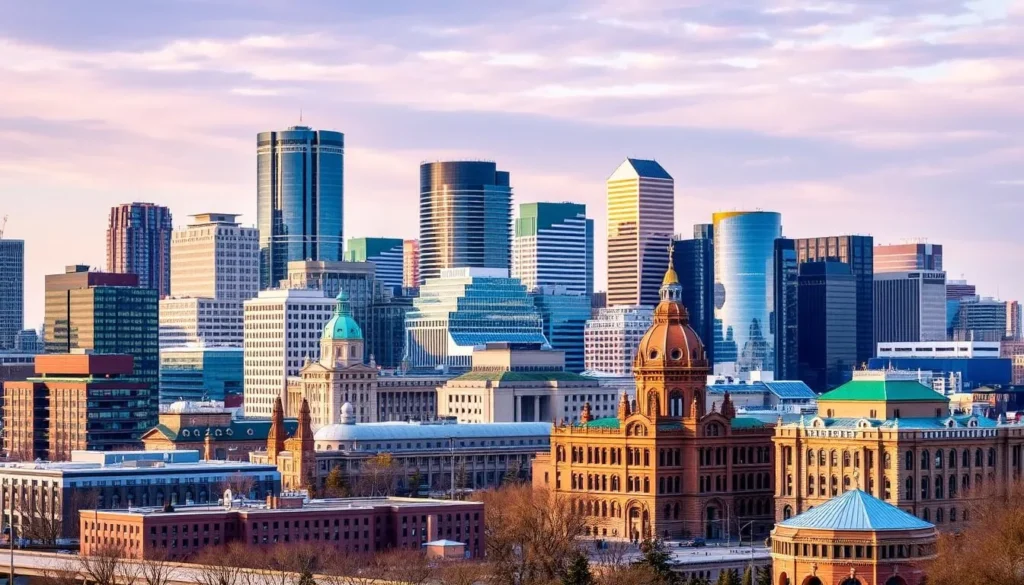
West Edmonton Mall: Shopping and Entertainment
One of Edmonton’s most famous attractions is West Edmonton Mall, North America’s largest shopping and entertainment complex. This massive mall features over 800 stores, 100 dining venues, and numerous attractions, including World Waterpark, the world’s largest indoor waterpark, and Galaxyland, the world’s largest indoor amusement park.
In addition to its shopping and entertainment options, West Edmonton Mall is also home to an NHL-sized ice rink and a full-size replica of Christopher Columbus’s Santa Maria ship, making it a great destination for families and adventure-seekers.
Edmonton’s River Valley
Edmonton’s River Valley is another must-visit attraction, spanning 22 times the size of New York’s Central Park with over 160 kilometers of maintained pathways perfect for hiking, biking, and cross-country skiing. As a local, you can enjoy a relaxing float down the North Saskatchewan River, taking in the beautiful views of the city and its surroundings.
Royal Alberta Museum
The Royal Alberta Museum is a world-class institution that showcases Alberta’s natural and cultural history through extensive exhibits. The museum’s new downtown building, which reopened in 2018, features a massive collection of insects and a fascinating Indigenous cultures gallery, making it a great destination for history buffs and families.
In addition to these attractions, Edmonton is also known for its vibrant cultural scene, with numerous festivals and events throughout the year, earning it the nickname “Festival City.” From its bohemian Whyte Avenue district to its historic Fort Edmonton Park, there’s always something to see or do in this dynamic city.
Hot Springs and Mountain Spas
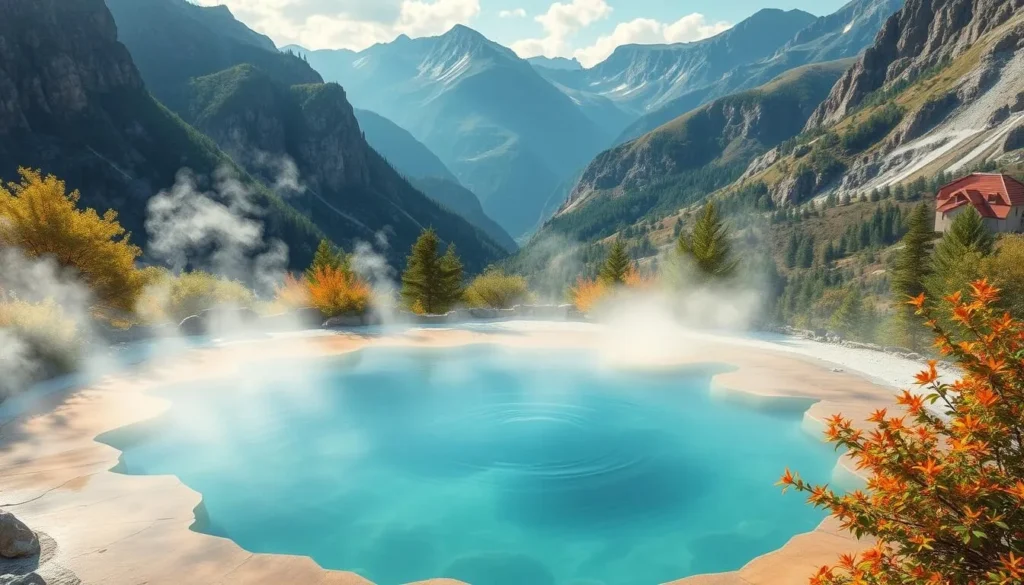
After a long day of exploring Alberta’s breathtaking landscapes, unwind at one of the province’s rejuvenating hot springs. Alberta’s hot springs offer a perfect way to relax and rejuvenate after exploring the mountain parks, with the added historical significance of being the reason Banff National Park was established.
The discovery of hot springs in the area led directly to the creation of Canada’s first national park. The Banff Upper Hot Springs, discovered in 1883, was the catalyst for this development. Today, visitors can soak in the 100% natural mineral water that flows from Sulphur Mountain at a temperature of 37-40°C (98-104°F).
Banff Upper Hot Springs
The Banff Upper Hot Springs facility offers a pool-like setting with lockers, rentals, and more. The historic bathhouse, built in 1932, maintains its heritage character while offering modern amenities, including rentals of vintage-style swimsuits for a unique photo opportunity.
The hot springs are rich in minerals such as calcium, magnesium, sodium, and potassium, which are believed to have therapeutic benefits for muscle relaxation and skin conditions. Soaking in the warm waters is a great way to unwind and rejuvenate after a day of exploring Banff National Park.
Miette Hot Springs in Jasper
Miette Hot Springs in Jasper National Park claims the title of hottest springs in the Canadian Rockies, with source waters emerging from the mountain at a scalding 54°C (129°F) before being cooled to a comfortable soaking temperature. The hot springs are located in a stunning mountain valley, offering four pools of varying temperatures and breathtaking mountain views.
The 60 km drive from Jasper town is well worth the trip, as you can relax in the natural hot springs and enjoy the serene surroundings. Whether you’re looking to relax or rejuvenate, Miette Hot Springs is a must-visit destination in Jasper National Park.
Wildlife Viewing Opportunities
Alberta’s varied ecosystems support a wide range of iconic Canadian wildlife, making it a prime destination for wildlife viewing. From the majestic Rocky Mountains to the vast prairies, Alberta offers some of North America’s best wildlife viewing opportunities.
Bear Watching in the National Parks
Bear watching is a highlight for many visitors to Alberta, with both black bears and grizzly bears frequently spotted from safe distances along roadways and hiking trails in Jasper National Park and Banff National Park. The best times for bear viewing are early morning and evening during spring and fall, when bears are most active foraging for food before and after hibernation.
Elk Island National Park: Bison and More
Elk Island National Park, just 35 minutes east of Edmonton, is home to the densest population of hoofed mammals in Canada and played a crucial role in saving the plains bison from extinction. As one of the few fully-fenced national parks in North America, Elk Island provides sanctuary to over 400 plains bison, 300 wood bison, moose, deer, and more than 250 species of birds.
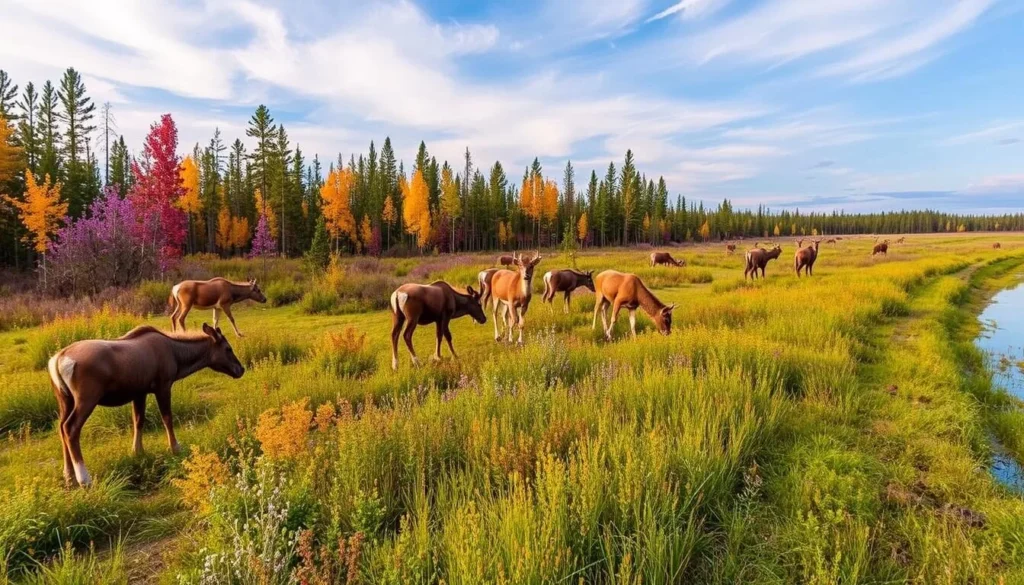
Wild Horses of Alberta
The wild horses of Alberta represent one of the last free-roaming horse populations in North America, with approximately 1,000 feral horses living primarily in the foothills of the Rocky Mountains. These wild horses are descendants of domestic horses used in logging and mining operations in the early 20th century and now roam in family bands across public lands in western Alberta.
For responsible wildlife viewing, always maintain a distance of at least 100 meters from bears and wolves and 30 meters from all other wildlife, using binoculars or telephoto lenses for closer observation. Jasper National Park is considered one of the best places in the world to spot wildlife, with its vast wilderness areas and relatively lower visitor numbers compared to Banff creating ideal conditions for animal sightings.
Wildlife viewing in Jasper National Park is particularly rewarding along the Maligne Lake Road, Medicine Lake, and the Pyramid Lake area, where visitors frequently spot bears, elk, bighorn sheep, and occasionally wolves. Whether you’re exploring the national parks or visiting the Canadian Badlands, Alberta offers a world-class wildlife viewing experience.
Scenic Gondola Rides
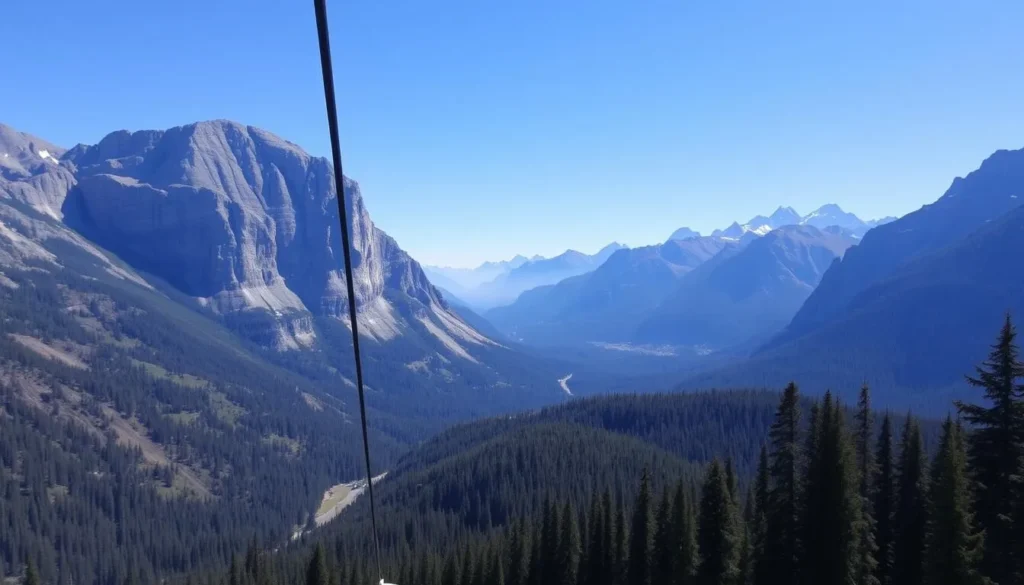
Experience the breathtaking beauty of Alberta from above with its scenic gondola rides. Alberta’s mountain gondolas offer visitors of all ages and abilities the chance to experience breathtaking alpine views without the physical demands of hiking to high elevations.
Banff Gondola on Sulphur Mountain
The Banff Gondola on Sulphur Mountain is one of Alberta’s most popular attractions, carrying visitors to an elevation of 2,281 meters in just eight minutes and offering spectacular 360-degree views of six mountain ranges. At the top, you can explore the multi-level interpretive center, dine at the Sky Bistro with floor-to-ceiling windows, and walk the 1-kilometer Sulphur Mountain Boardwalk to the historic Cosmic Ray Station.
Lake Louise Summer Gondola
The Lake Louise Summer Gondola offers a unique wildlife viewing opportunity, as the area is known for grizzly bear sightings, with trained staff pointing out bears safely foraging on the slopes below. From the top, you enjoy spectacular views of Lake Louise, Victoria Glacier, and the surrounding mountain peaks, with options for guided hikes and an excellent wildlife interpretive center.
Mt. Norquay Chairlift
Mt. Norquay’s North American Chairlift provides a more open-air experience on a traditional ski lift, rising to 2,090 meters and offering some of the best views of the town of Banff and the Bow Valley. The historic Cliffhouse Bistro at the top was originally built in 1950 and offers a unique dining experience with panoramic mountain views and locally-sourced cuisine.
In Jasper National Park, the Jasper SkyTram climbs to 2,277 meters up Whistlers Mountain, where you can hike the additional 1.4 kilometers to the summit for views of six mountain ranges and the entire Athabasca Valley. Each gondola experience offers something unique: Banff Gondola for the most developed facilities, Lake Louise for wildlife viewing, Mt. Norquay for views of Banff town, and Jasper SkyTram for the most wilderness-oriented experience.
Waterton Lakes National Park: Hidden Gem
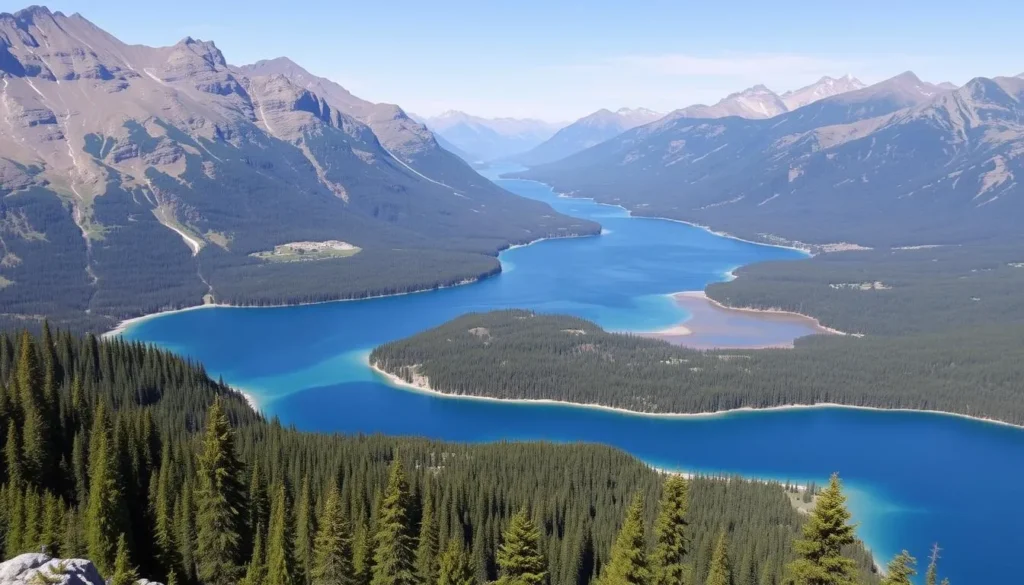
Tucked away in the southwestern corner of Alberta, Waterton Lakes National Park is a treasure trove of natural beauty. This stunning national park is often overlooked by international visitors, but it’s cherished by locals as one of the province’s most beautiful hidden gems.
Where the Mountains Meet the Prairies
The park is part of the Waterton-Glacier International Peace Park, the world’s first international peace park formed in 1932 when Waterton Lakes National Park in Canada and Glacier National Park in the United States were joined together. What makes Waterton unique is its dramatic meeting point of ecosystems, where the mountain landscapes rise abruptly from the prairie landscape without the typical foothills transition seen elsewhere in Alberta.
The park’s compact size, spanning 505 square kilometers, means visitors can experience diverse landscapes from prairie to alpine in a single day, making it perfect for those with limited time. You can explore the historic Prince of Wales Hotel, perched on a bluff overlooking Upper Waterton Lake, which offers spectacular views and afternoon tea service during the summer season.
Red Rock Canyon and Cameron Falls
One of the park’s striking attractions is Red Rock Canyon, a geological formation where you can walk along the canyon rim or wade through the shallow red-colored waters that have carved through the ancient argillite rock. Additionally, Cameron Falls, located right in the Waterton townsite, is one of the most accessible and photographed waterfalls in Alberta, with a viewing platform that allows you to get close to the cascading waters.
The park also offers excellent hot springs experiences nearby at the Waterton Hot Springs, where you can soak in mineral-rich waters while enjoying mountain views. With its relatively remote location, about 3 hours from Calgary, and smaller size, Waterton sees far fewer visitors than Banff or Jasper, offering a more peaceful place to experience the beauty of the mountains.
After the Kenow Wildfire in 2017, the park has undergone a fascinating ecological recovery process, and visitors today can witness the landscape regenerating, providing a unique perspective on nature’s resilience. Whether you’re looking for things to do or simply want to enjoy the scenery, Waterton Lakes National Park is a must-visit destination in Alberta.
Indigenous Culture and History
Alberta’s rich Indigenous heritage is a treasure trove of history and culture, waiting to be explored. The province is home to numerous sites that showcase the traditions and stories of its Indigenous peoples.
Head-Smashed-In Buffalo Jump
One of Alberta’s most significant Indigenous sites is the Head-Smashed-In Buffalo Jump, a UNESCO World Heritage Site located about 60 miles south of Lethbridge. This ancient buffalo jump was used by Indigenous peoples for nearly 6,000 years as a hunting technique, where they would herd buffalo over a massive cliff to harvest their meat, hides, and bones.
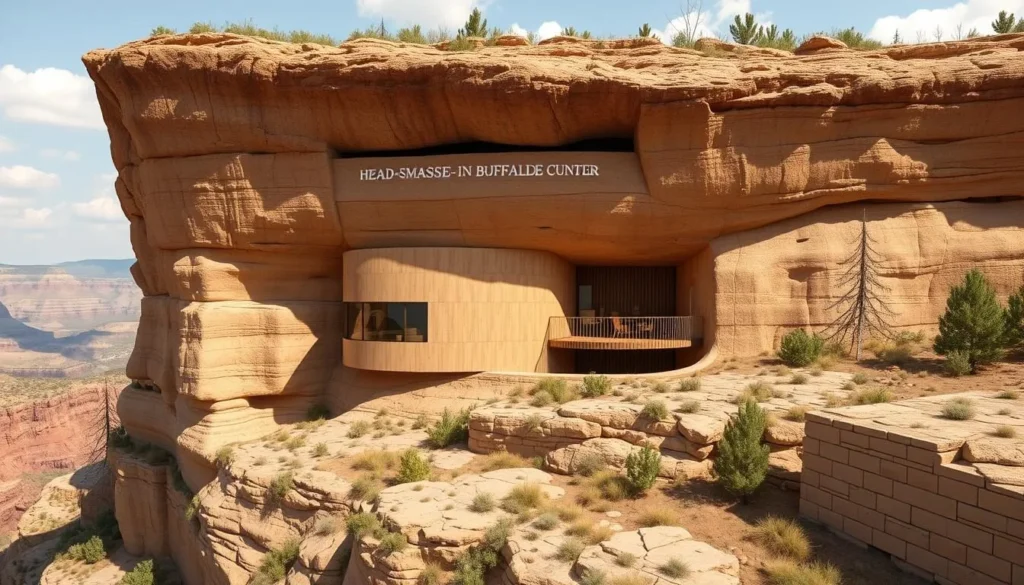
The site’s unusual name comes from a Blackfoot legend about a young man who wanted to witness the buffalo plunging over the cliff from below, only to be found later with his head smashed in by the falling animals. Today, visitors can explore the interpretive center and learn about the history and significance of this site.
Writing-on-Stone Provincial Park
Another important Indigenous site in Alberta is the Writing-on-Stone Provincial Park (Áísínai’pi), located in the southeastern part of the province. This park contains the largest concentration of rock art on the North American Great Plains, with over 50 petroglyph sites and thousands of individual carvings.
The sacred landscape at Writing-on-Stone features hoodoos and cliffs adorned with petroglyphs and pictographs created by the Blackfoot people that date back as far as 3,000 years. In 2019, the park was designated as a UNESCO World Heritage Site in recognition of its cultural significance and the need to protect these irreplaceable records of Indigenous history and spirituality.
Throughout Alberta, visitors can experience Indigenous culture through guided tours, cultural centers, museums, and Indigenous-owned tourism businesses that share authentic stories and traditions. The Blackfoot Crossing Historical Park on the Siksika Nation Reserve east of Calgary offers another important cultural experience, with exhibits on Blackfoot history, traditional dwellings, and the site where Treaty 7 was signed in 1877.
Alberta’s Festivals and Events
As you plan your trip to Alberta, you’ll find that the province is alive with festivals and events that showcase its rich heritage and culture. From music festivals to cultural celebrations, there’s always something happening in Alberta, making it an exciting destination for visitors.
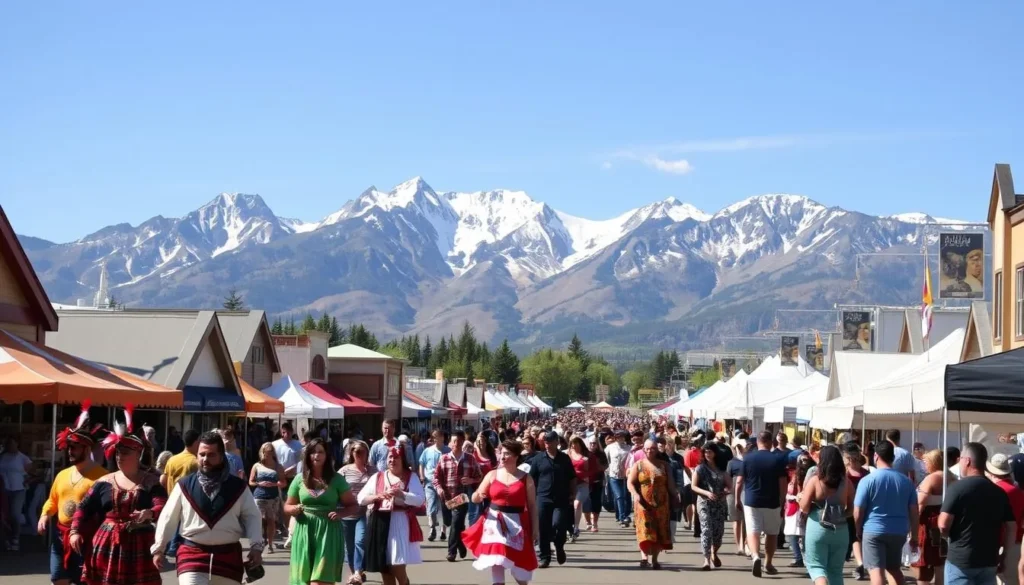
Calgary Folk Music Festival
The Calgary Folk Music Festival is a highlight of the summer calendar, transforming Prince’s Island Park into a musical haven each July. With over 70 artists performing across seven stages over four days, this festival is a must-visit for music lovers. Beyond the music, the festival creates a vibrant village atmosphere with a family area, artisan market, global food vendors, and beer gardens where attendees can relax on tarps and blankets between performances.
Edmonton Fringe Theatre Festival
The Edmonton Fringe Theatre Festival is the oldest and largest fringe festival in North America, featuring over 1,600 live performances across more than 40 venues. This 11-day theatrical celebration takes over Edmonton’s historic Old Strathcona district each August, with street performers, food vendors, and an atmosphere of creative experimentation that draws over 800,000 visitors.
Seasonal Celebrations Across the Province
Alberta’s festivals and events are not limited to summer. Winter festivals like the Ice Magic Festival in Lake Louise showcase incredible ice sculptures, while the Jasper Dark Sky Festival celebrates the park’s status as a dark sky preserve with astronomy activities. The province also hosts harvest festivals in the fall, Christmas markets in winter, and spring events like the Calgary Lilac Festival, ensuring that there’s always something to celebrate, no matter the season.
Alberta’s craft beer scene also comes alive during events like the Calgary International Beerfest and Edmonton Craft Beer Festival, showcasing hundreds of breweries from across the province and beyond. Whether you’re interested in music, theater, or beer, Alberta’s festivals and events have something for everyone, making it a great place to visit at any time of the year.
Planning Your Alberta Adventure
With its vast distances and diverse attractions, planning your Alberta adventure requires some preparation to ensure you experience the best things this Canadian province has to offer. Whether you’re driving along the Icefields Parkway, one of the most scenic drives in the world, or exploring the vibrant cities of Calgary and Edmonton, having a well-planned itinerary is key.
First and foremost, consider the time of year you plan to visit. Alberta is a year-round destination, with summer (June-August) offering warm weather and access to all attractions, fall (September-October) bringing stunning foliage and fewer crowds, winter (November-March) being perfect for snow activities, and spring (April-May) offering moderate temperatures and excellent wildlife viewing opportunities.
When visiting Canada’s national parks, including Banff, Jasper, and Waterton Lakes, make sure to obtain a Parks Canada Pass. The Parks Canada Discovery Pass ($75.25 CAD for adults) provides unlimited access to all national parks for a full year, making it the best value if you plan to spend days exploring multiple parks.
For those with bucket list destinations like Lake Louise or Moraine Lake, plan to arrive very early in the morning (before 6 AM in summer) or use shuttle services to avoid parking challenges. Additionally, consider adding lesser-known destinations to your itinerary, such as the Canadian Badlands or the Peace Country in northern Alberta, to experience areas that are equally beautiful but less crowded.
Alberta’s major international airports are in Calgary and Edmonton, with Calgary being the preferred entry point for visitors heading to the Rocky Mountains, while Edmonton offers better access to northern Alberta attractions. Renting a car is highly recommended when visiting Alberta, as public transportation between major attractions is limited, though guided tours are available from Calgary and Edmonton to popular destinations.
The province experiences four distinct seasons, with summer temperatures averaging 15-25°C (59-77°F), while winter temperatures can drop to -30°C (-22°F) or lower. Thus, timing your visit to match your preferred activities and tolerance for weather conditions is essential. Don’t forget to pack layers, as the weather in Alberta can change rapidly, especially in the mountains.
Lastly, when engaging in wildlife viewing, one of the best things to do in Alberta, always maintain a safe distance (at least 100 meters from bears and wolves, 30 meters from other wildlife) and never feed or approach wild animals. With these tips and a bit of planning, you’re ready to embark on an unforgettable road trip through one of North America’s most beautiful regions.
—
The above is subject to change.
Check back often to TRAVEL.COM for the latest travel tips and deals.
